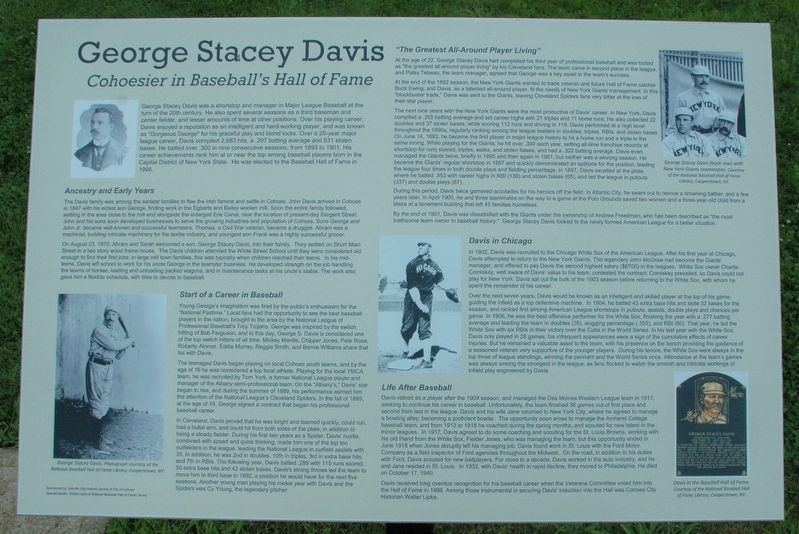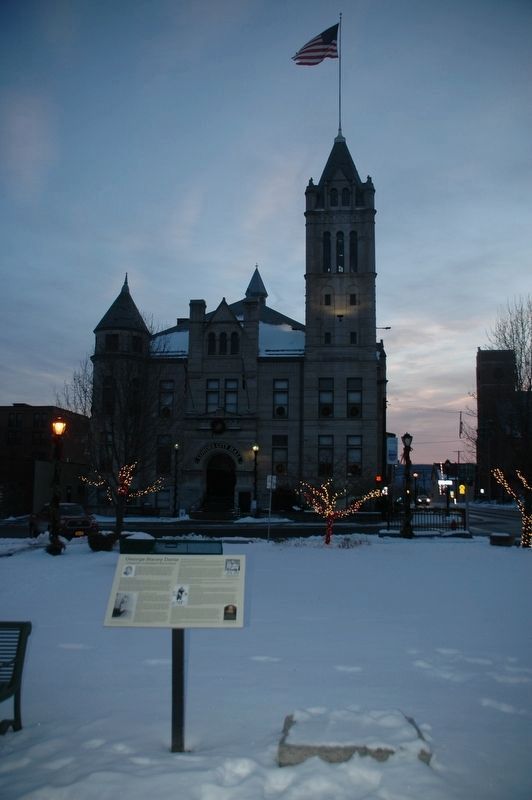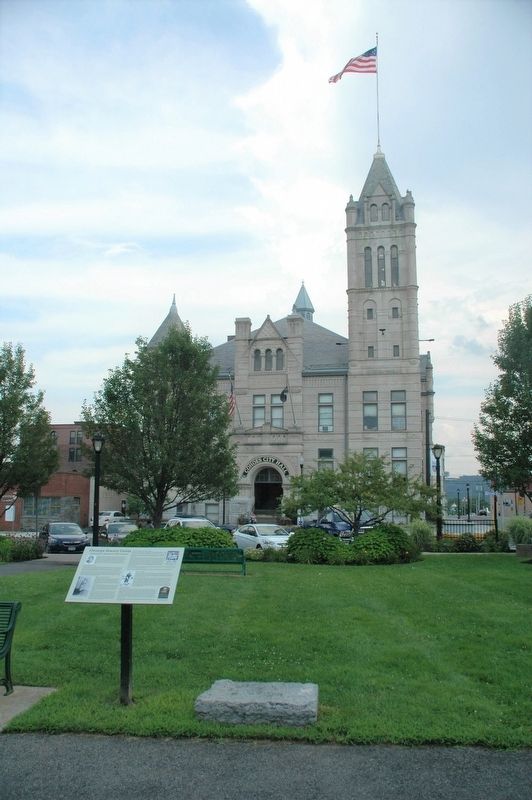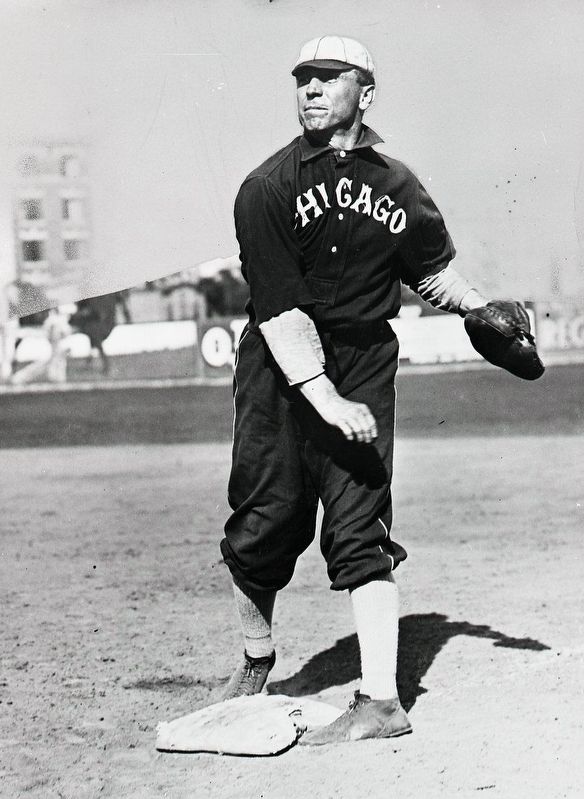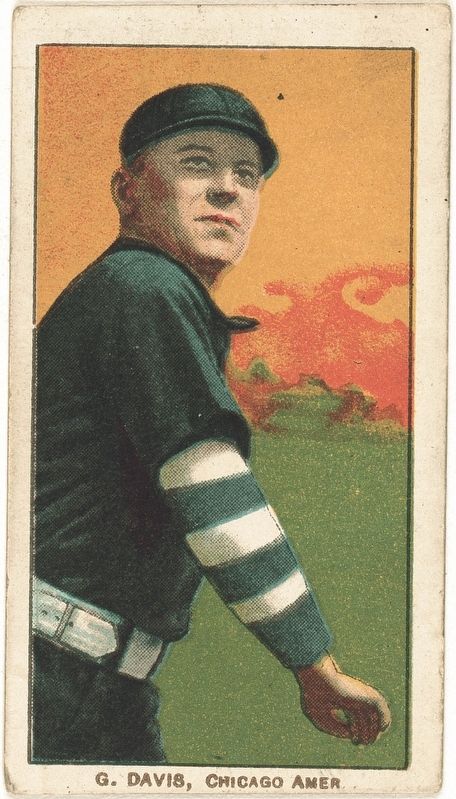Cohoes in Albany County, New York — The American Northeast (Mid-Atlantic)
George Stacey Davis
Cohoesier in Baseball's Hall of Fame
George Stacey Davis was a shortstop and manager in Major League Baseball at the turn of the 20th century. He also spent several seasons as a third baseman and center fielder, and lesser amounts of time at other positions. Over his playing career, Davis enjoyed a reputation as an intelligent and hard-working player, and was known as “Gorgeous George” for this graceful play and blond locks. Over a 20-year major league career, Davis complied 2,683 hits, a .297 batting average and 631 stolen bases. He batted over .300 in nine consecutive seasons, from 1893 to 1901. His career achievements rank him at or near the top among baseball players born in the Capital District of New York State. He was elected to the Baseball Hall of Fame in 1998.
Ancestry and Early Years
The Davis family was among the earliest families to flee the Irish famine and settle in Cohoes. John Davis arrived in Cohoes in 1847 with his eldest son George, finding work in the Egberts and Bailey woolen mill. Soon the entire family followed, settling in the area close to the mill and alongside the enlarged Erie Canal, near the location of present-day Sargent Street. John and his sons soon developed businesses to serve the growing industries and population of Cohoes. Sons George and John Jr. became well-known and successful teamsters. Thomas, a Civil War veteran, became a druggist. Abram was a machinist, building intricate machinery for the textile industry, and youngest son Frank was a highly successful grocer.
On August 23, 1870, Abram and Sarah welcomed a son, George Stacey Davis, into their family. They settled on Short Main Street in a two story wood frame house. The Davis children attended the White Street School until they were considered old enough to find their first jobs; in large mill town families, this was typically when children reached their teens. In his mid-teens, Davis left school to work for his uncle George in the teamster business. He developed strength on the job handling the teams of horses, loading and unloading packed wagons, and in maintenance tasks at his uncle's stable. The work also gave him a flexible schedule, with time to devote to baseball.
Start of a Career in Baseball
Young George's imagination was fired by the public's enthusiasm for the "National Pastime.” Local fans had the opportunity to see the best baseball players in the nation, brought to the area by the National League of Professional Baseball's Troy Trojans. George was inspired by the switch hitting of Bob Ferguson, and to this day, George S. Davis is considered one of the top switch hitters of all time. Mickey Mantle, Chipper Jones, Pete Rose, Roberto Alomar, Eddie Murray, Reggie Smith, and Bernie Williams share that list with Davis.
The teenaged Davis began playing on local Cohoes youth teams, and by the age of 16 he was considered a top local athlete. Playing for the local YMCA team, he was recruited by Tom York, a former National League player and manager of the Albany semi-professional team. On the "Albany's,” Davis' star began to rise, and during the summer of 1889, his performance earned him the attention of the National League's Cleveland Spiders. In the fall of 1889, at the age of 19, George signed a contract that began his professional baseball career.
In Cleveland, Davis proved that he was bright and learned quickly, could run, had a bullet arm, and could hit from both sides of the plate, in addition to being a steady fielder. During his first two years as a Spider, Davis' hustle, combined with speed and quick thinking, made him one of the top ten outfielders in the league, leading the National League in outfield assists with 35. In addition, he was 2nd in doubles, 10th in triples, 3rd in extra base hits and 7th in RBIs. The following year, Davis batted .289 with 115 runs scored, 50 extra base hits and 42 stolen bases. Davis's strong throws led the team to move him to third base in 1892, a position he would have for the next five seasons. Another young man playing his rookie year with Davis and the Spiders was Cy Young,
the legendary pitcher.
“The Greatest All-Around Player Living”
At the age of 22, George Stacey Davis had completed his third year of professional baseball and was touted as "the greatest all-around player living” by his Cleveland fans. The team came in second place in the leaque and Patsy Tebeau, the team manager, agreed that George was a key asset in the team's success.
At the end of the 1892 season, the New York Giants wanted to trade veteran and future Hall of Fame catcher Buck Ewing, and Davis, as a talented all-around player, fit the needs of New York Giants management. In this blockbuster trade,” Davis was sent to the Giants, leaving Cleveland Spiders fans very bitter at the loss of their star player.
The next nine years with the New York Giants were the most productive of Davis' career. In New York, Davis compiled a .355 batting average and set career highs with 27 triples and 11 home runs. He also collected 22 doubles and 37 stolen bases, while scoring 112 runs and driving in 119. Davis performed at a high level throughout the 1890s, regularly ranking among the league leaders in doubles, triples, RBIs, and stolen bases. On June 14, 1893, he became the first player in major league history to hit a home run and a triple in the same inning. While playing for the Giants, he hit over .300 each year, setting all-time franchise records at shortstop for runs scored, triples, walks, and stolen bases, and had a .322 batting average. Davis even managed the Giants twice, briefly in 1895 and then again in 1901, but neither was a winning season. He became the Giants' regular shortstop in 1897 and quickly demonstrated an aptitude for the position, leading the league four times in both double plays and fielding percentage. In 1897, Davis excelled at the plate where he batted .353 with career highs in RBI (136) and stolen bases (65), and led the league in putouts (337) and double plays (67).
During this period, Davis twice garnered accolades for his heroics off the field. In Atlantic City, he swam out to rescue a drowning bather, and a few years later, in April 1900, he and three teammates on the way to a game at the Polo Grounds saved two women and a three-year-old child from a blaze at a tenement building that left 45 families homeless.
By the end of 1901, Davis was dissatisfied with the Giants under the ownership of Andrew Freedman, who has been described as "the most loathsome team owner in baseball history.” George Stacey Davis looked to the newly formed American League for a better situation.
Davis in Chicago
In 1902, Davis was recruited to the Chicago White Sox of the American League. After his first year at Chicago, Davis attempted to return to the New York Giants. The legendary John McGraw had become the Giants' manager, and offered to pay Davis the second highest salary ($6700) in the leagues. White Sox owner Charlie Comiskey, well aware of Davis' value to his team, contested the contract. Comiskey prevailed, so Davis could not play for New York. Davis sat out the bulk of the 1903 season before returning to the White Sox, with whom he spent the remainder of his career.
Over the next seven years, Davis would be known as an intelligent and skilled player at the top of his game, guiding the infield as a top defensive machine. In 1904, he batted 43 extra base hits and stole 32 bases for the season, and ranked first among American League shortstops in putouts, assists, double plays and chances per game. In 1906, he was the best offensive performer for the White Sox, finishing the year with a .277 batting average and leading the team in doubles (26), slugging percentage (.355), and RBI (80). That year, he led the White Sox with six RBIs in their victory over the Cubs in the World Series. In his last year with the White Sox, Davis only played in 28 games; his infrequent appearances were a sign of the cumulative effects of career injuries. But he remained a valuable asset to the team, with his presence on the bench providing the guidance of a seasoned veteran very supportive of the younger players. During his tenure, the White Sox were always in the top three of league standings, winning the pennant and the World Series once. Attendance at the team's games was always among the strongest in the league, as fans flocked to watch the smooth and intricate workings of infield play engineered by Davis.
Life After Baseball
Davis retired as a player after the 1909 season, and managed the Des Moines Western League team in 1911 seeking to continue his career in baseball. Unfortunately, the team finished 36 games out of first place and second from last in the league. Davis and his wife Jane returned to New York City, where he agreed to manage a bowling alley, becoming a proficient bowler. The opportunity soon arose to manage the Amherst College baseball team, and from 1913 to 1918 he coached during the spring months, and scouted for new talent in the minor leagues. In 1917, Davis agreed to do some coaching and scouting for the St. Louis Browns, working with his old friend from the White Sox, Fielder Jones, who was managing the team, but this opportunity ended in June 1918 when Jones abruptly left his managing job. Davis found work in St. Louis with the Ford Motor Company as a field inspector of Ford agencies throughout the Midwest. On the road, in addition to his duties with Ford, Davis scouted for new ballplayers. For close to a decade, Davis worked in the auto industry, and he and Jane resided in St. Louis. In 1932, with Davis' health in rapid decline, they moved to Philadelphia. He died on October 17, 1940.
Davis received long overdue recognition for his baseball career when the Veterans Committee voted him into the Hall of Fame in 1998. Among those instrumental in securing Davis' induction into the Hall was Cohoes City Historian Walter Lipka.
Erected by Spindle City Historic Society & City of Cohoes.
Topics and series. This historical marker is listed in this topic list: Sports. In addition, it is included in the Baseball Hall of Famers series list. A significant historical year for this entry is 1847.
Location. 42° 46.476′ N, 73° 42.028′ W. Marker is in Cohoes, New York, in Albany County. Marker can be reached from Mohawk Street. The marker is in the Horace Silliman Memorial Park which is on the west side of Mohawk Street directly opposite Cohoes City Hall. The park is the former location of the Silliman Memorial Church. Touch for map. Marker is in this post office area: Cohoes NY 12047, United States of America. Touch for directions.
Other nearby markers. At least 8 other markers are within walking distance of this marker. Horace B. Silliman (here, next to this marker); Cohoes City Hall (within shouting distance of this marker); First Power Mill for the Manufacture of Knit Fabrics (about 500 feet away, measured in a direct line); Egberts & Bailey Mill (about 500 feet away); The Erie Canal (approx. 0.4 miles away); Cohoes - Waterford Bridge (approx. 0.4 miles away); The Cohoes Mastodont (approx. 0.4 miles away); White Homestead (approx. half a mile away). Touch for a list and map of all markers in Cohoes.
Also see . . .
1. George Stacy Davis on Find-A-Grave.com. (Submitted on August 8, 2018, by Howard C. Ohlhous of Duanesburg, New York.)
2. Major League Baseball Statistics for George Davis. (Submitted on August 8, 2018, by Howard C. Ohlhous of Duanesburg, New York.)
3. Cohoes History website article on George Stacy Davis. (Submitted on August 8, 2018, by Howard C. Ohlhous of Duanesburg, New York.)
4. Society For American Baseball Research article on George Davis. (Submitted on August 8, 2018, by Howard C. Ohlhous of Duanesburg, New York.)
Credits. This page was last revised on January 19, 2022. It was originally submitted on July 23, 2018, by Howard C. Ohlhous of Duanesburg, New York. This page has been viewed 352 times since then and 23 times this year. Last updated on January 18, 2022, by Carl Gordon Moore Jr. of North East, Maryland. Photos: 1. submitted on July 23, 2018, by Howard C. Ohlhous of Duanesburg, New York. 2, 3, 4, 5. submitted on August 8, 2018, by Howard C. Ohlhous of Duanesburg, New York. • J. Makali Bruton was the editor who published this page.
